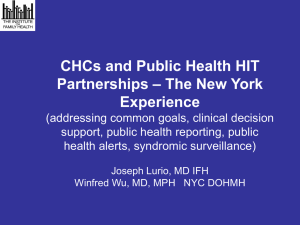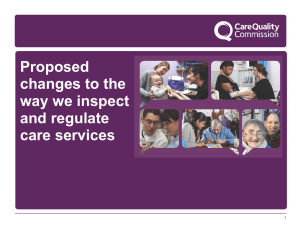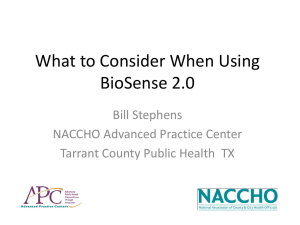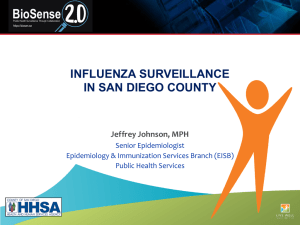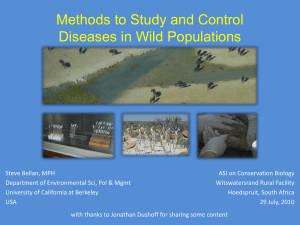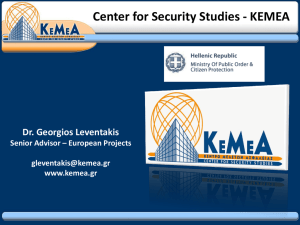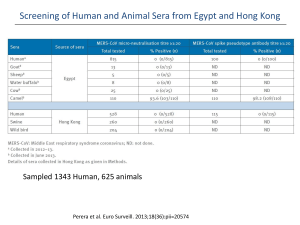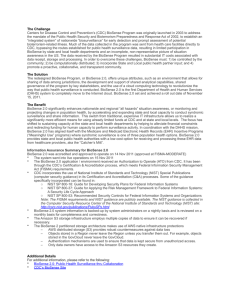Alan Siniscalchi - International Society for Disease Surveillance
advertisement
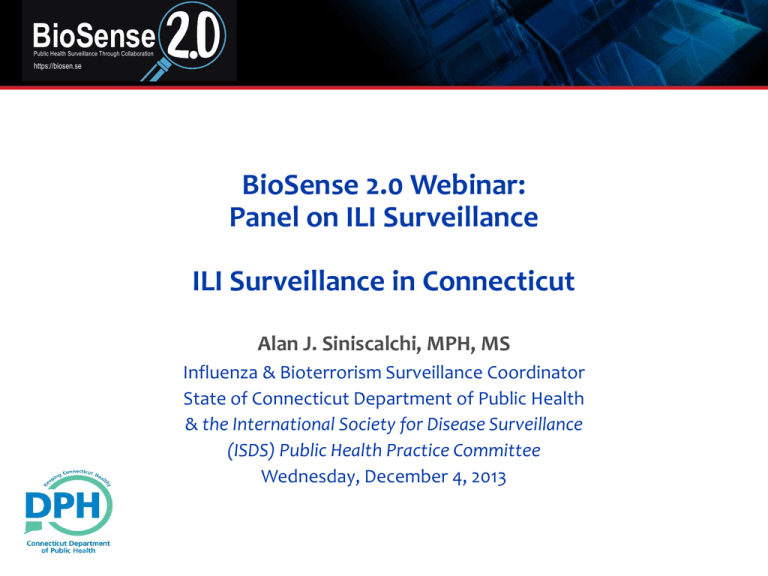
BioSense Public Health Surveillance Through Collaboration https://biosen.se BioSense 2.0 Webinar: Panel on ILI Surveillance ILI Surveillance in Connecticut Alan J. Siniscalchi, MPH, MS Influenza & Bioterrorism Surveillance Coordinator State of Connecticut Department of Public Health & the International Society for Disease Surveillance (ISDS) Public Health Practice Committee Wednesday, December 4, 2013 BioSense Public Health Surveillance Through Collaboration https://biosen.se Presentation Objectives 1. 2. 3. 4. To outline the types of surveillance systems designed for detecting influenza, bioterrorism agents, and emerging infections in Connecticut To describe how these systems have been used to track ILI and flu-associated morbidity and mortality throughout the state To discuss which surveillance systems provide the best value for use in the identification and tracking of influenza outbreaks To emphasize the value of providing real-time data in assessing risk, reducing exposure, and preventing disease BioSense Public Health Surveillance Through Collaboration https://biosen.se Surveillance Objectives: Why should health departments conduct ongoing surveillance for seasonal influenza & emerging diseases? 1. 2. 3. Situational Awareness (to detect and track emerging agents and disease activity) Health Professional Awareness and Asset Management (to provide necessary information for optimal use of vaccine supplies, etc.) Public Education & Risk Communication (to provide sufficient information to members of the public to enable them to make informed choices) BioSense Public Health Surveillance Through Collaboration https://biosen.se Surveillance Systems in Connecticut by Category (arranged by group and speed of detection): How soon do you want to know? Group 7. Mortality Surveillance: 122 Cities, Pediatric mortality Group 6. Traditional Laboratory Surveillance: Flu subtypes Group 5. Reportable Disease Surveillance: State & federal Group 4. Special Hospitalization & Laboratory Surveillance: Flu-associated hospitalizations, GPR testing for anthrax Group 3. Other Surveillance: Institutional outbreaks Value: These provide important, but slow (many days after exposure) information on the etiological agent & characterization of the disease and risk factors. . BioSense Public Health Surveillance Through Collaboration https://biosen.se Surveillance Systems in Connecticut, cont. Group 2. Syndromic Surveillance (early symptoms, hours – days after exposure): These systems measure ILI before diagnosis and laboratory confirmation, including ILINet outpatient providers; the CT Hospital Admissions Syndromic Surveillance (HASS) System, established in all 32 CT acute care hospital campuses following September 11, 2001; the CT Hospital Emergency Department Syndromic Surveillance (HEDSS) System, in operation since 2004; BioSense & others Value: For situational awareness & rapid identification and tracking of severe outbreaks & epidemics. BioSense Public Health Surveillance Through Collaboration https://biosen.se Surveillance Systems in Connecticut, cont. Group 1. Remote Collection & Sensing Surveillance (dispersal, before widespread exposure): A variety of state and federal systems are available for real-time detection of bioterrorist agents. Remote thermal imagining systems can be used in airports and other transportation centers to detect travelers with influenza and other febrile illness. Value: Development and implementation of an expanded network of thermal imaging and other automated remote sensing systems would provide early detection and management of imported cases. BioSense Public Health Surveillance Through Collaboration https://biosen.se Figure 1. Laboratory Confirmed Tests by Influenza Type and Subtype During the 2009 Influenza A (H1N1) Pandemic in Connecticut 1900 1800 Type A (H1N1) Novel 2009 Type A (Unsubtypeable) 1700 1600 Type Type Type Type 1400 1300 1200 1100 1000 A (H1N1) Seasonal A (H3N2) Seasonal A (Unspecified) B Seasonal Type Unknown 900 800 700 600 500 400 300 200 100 MMWR Week (April 2009 - May 2010) 20 18 16 14 12 10 8 6 4 2 52 50 48 46 44 42 40 38 36 34 32 30 28 26 24 22 20 18 0 16 No. Tests Reported 1500 BioSense Public Health Surveillance Through Collaboration https://biosen.se Figure 2. CT ILINet Physician Provider % Influenza-like Illness (ILI) Visits vs. Hospital Emergency Department Syndromic Surveillance (HEDSS) System % “Fever/Flu” ED Visits (April 2009-April 2010) 15 18 14 14 11 10 12 9 10 8 7 8 6 5 6 4 4 3 2 2 1 MMWR Weeks (April 2009 – April 2010) ILINet Providers % ILI Visits HEDSS % Fever/Flu ED Visits 13 11 9 7 5 3 1 51 49 47 45 43 41 39 37 35 33 31 29 27 25 23 21 19 0 17 0 15 ILINet Providers % ILI Visits 12 HEDSS % Fever/Flu ED Visits 16 13 BioSense Public Health Surveillance Through Collaboration https://biosen.se Figure 3: Connecticut Hospital Admissions Syndromic Surveillance (HASS) System, Percent of total statewide admissions for pneumonia; 2011-12, 2012-13, 2013-14 12 10 Percent of total admissions 2011-12 2012-13 8 2013-14 6 4 2 0 MMWR week BioSense Public Health Surveillance Through Collaboration https://biosen.se Figure 4. Temporal and Regional Trends during the Novel H1N1 Influenza Pandemic, Connecticut Hospital Emergency Department Syndromic Surveillance (HEDSS) System: Percent of ED visits for “fever/flu” syndrome category, April 12, 2009 – April 24, 2010 25% Region 3 20% Region 5 Region 4 Region 2 Region 1 15% 10% 5% Fall 2009 H1N1 Wave Spring 2009 H1N1 Wave 0% 15 17 19 21 23 25 27 29 31 33 35 37 39 41 43 MMWR Week 45 47 49 51 1 3 5 7 9 11 13 15 BioSense Public Health Surveillance Through Collaboration https://biosen.se Conclusions and Recommendations 1. 2. 3. Various syndromic and other advanced surveillance systems all provide valuable data useful for state and local jurisdiction efforts to detect outbreaks, identify emerging disease, and track influenza The value of ED-based and other syndromic surveillance systems in providing real-time data cannot be understated Continued efforts to automate these systems will also reduce the demand on increasingly limited public agency resources and allow agencies to maintain a wide network of systems resulting in a superior level of public health preparedness BioSense Public Health Surveillance Through Collaboration https://biosen.se Acknowledgements The CT DPH Influenza & BT Surveillance Teams (2003 - present): Zygmunt F. Dembek, PhD, MS, MPH*; Maria T. Andrews, MPH*; Roxanne Ryan*; Sara A. Niesobecki, MS* & other interns; Brenda Esponda, BS, BA; Jianxin Sun, MD, PhD; Amanda Morrison, MPH*; Stephanie Petrahai, MPH*; & Nancy Barrett, MS, MPH; Susan Petit, MPH, Heather Altier, BA; Zack Fraser, BS; Field Epidemiologists: Jessica Brockmeyer, MPH; Kasia Frenette, MPH*; Paul Gacek, MPH; Jaime Krasnitski, MPH; Lisa LoBianco Pippa, MPH*; Ava Nepaul, MPH*; Katherine M. Purviance, MPH*; Kristen Soto, MPH; along with Terry Rabatsky-Ehr, MPH; Randall S. Nelson, DVM, MPH; Pat Mshar, MPH*; & Matthew L. Cartter, MD, MPH; Lynn Sosa-Bergeron, MD; James L. Hadler, MD, MPH*; CDC EIS Officers; & lab support by Tim Brennan, Diane Barden, & others; (*former team member) Questions? alan.siniscalchi@ct.gov
